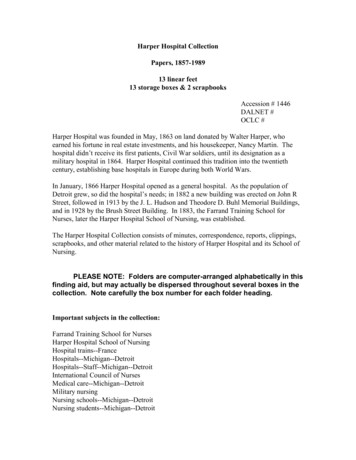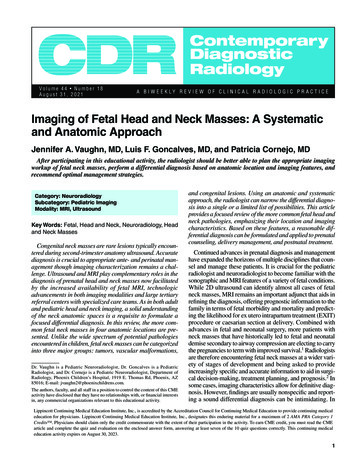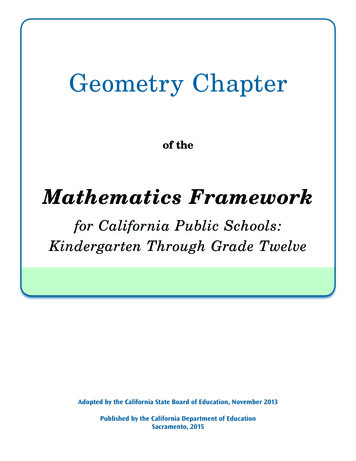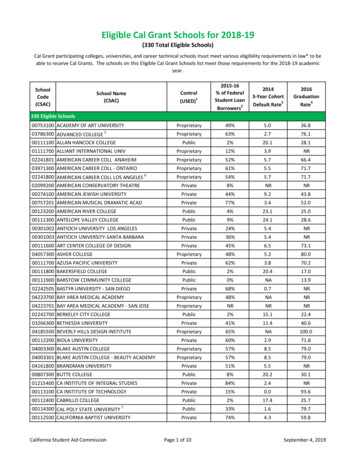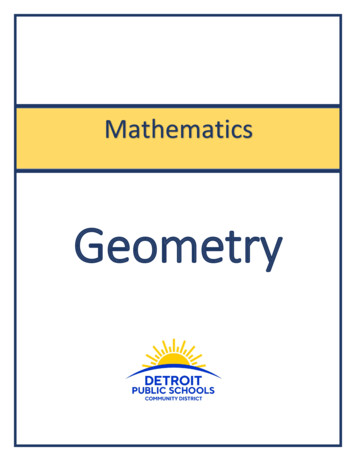
Transcription
MathematicsGeometry
2Letter to Families from the DPSCD Office of MathematicsDear DPSCD Families,The Office of Mathematics is partnering with families to support Distance Learning while students arehome. We empower you to utilize the resources provided to foster a deeper understanding of gradelevel mathematics.In this packet, you will find links to videos, links to online practice, and pencil-and-paper practiceproblems. The Table of Contents shows day-by-day lessons from April 14th to June 19th. Weencourage you to take every advantage of the material in this packet.Daily lesson guidance can be found in the table of contents below. Each day has been designed toprovide you access to materials from Khan Academy and the academic packet. Each lesson hasthis structure:Watch: Khan Academy (ifinternet access is available)Practice: Khan Academy (if internetaccess is available)Pencil & Paper Practice:Academic PacketWatch and take notes on thelesson video on Khan AcademyComplete the practice exercises onKhan AcademyComplete the pencil and paperpractice.If one-on-one, live support is required, please feel free to call the Homework Hotline at 1-833-4663978. Please check the Homework Hotline page for operating hours. We have DPSCD mathematicsteachers standing by and are ready to assist.We appreciate your continued dedication, support and partnership with Detroit Public SchoolsCommunity District and with your assistance we can press forward with our priority: OutstandingAchievement. Be safe. Be well!Tony R. HawkDeputy Executive Director of K-12 MathematicsPrinted math problems in this packet come from the CPM Educational Program. Open eBook access is available at http://open-ebooks.cpm.org/. 2009, 2014 CPMEducational Program. All rights reserved.
3Important Links and InformationCleverStudents access Clever by visiting www.clever.com/in/dpscd.What are my username and password for Clever?Students access Clever using their DPSCD login credentials. Usernames and passwords followthis structure:Username: studentID@thedps.orgEx. If Aretha Franklin is a DPSCD student with a student ID of 018765 her username would be018765@thedps.org.Password:First letter of first name in upper caseFirst letter of last name in lower case2-digit month of birth2-digit year of birth01 (male) or 02 (female)For example: If Aretha Franklin’s birthday is March 25, 1998, her password and passwordwould be Af039802.Accessing Khan AcademyTo access Khan Academy, visit www.clever.com/in/dpscd. Once logged into Clever, selectthe Khan Academy button:Printed math problems in this packet come from the CPM Educational Program. Open eBook access is available at http://open-ebooks.cpm.org/. 2009, 2014 CPMEducational Program. All rights reserved.
4Accessing Your CPM eBookStudents can access their CPM eBook in two ways:Option 1: Access the eBook through Clever1. Visit www.clever.com/in/dpscd. Login using your DPSCD credentials above.2. Click on the CPM icon:Option 2: Visit http://open-ebooks.cpm.org/1. Visit the website listed above.2. Click “I agree”3. Select the CPM Geometry eBook:Desmos Online Graphing CalculatorAccess to a free online graphing and scientific calculator can be found athttps://www.desmos.com/calculator.Printed math problems in this packet come from the CPM Educational Program. Open eBook access is available at http://open-ebooks.cpm.org/. 2009, 2014 CPMEducational Program. All rights reserved.
5Table of ContentsIn the following table, you will find the table of contents and schedule for the week of April13, 2020 through the week of June 15, 2020.WeekDateTopicWatch(10 minutes)Online Practice(10 minutes)Pencil & PaperPractice (25minutesDay 1HolidayN/AN/AN/A5.1.1-5.1.3 MoreTrigonometryIntro to Trig FunctionsTrigonometryPracticeProblems 1-65.1.1-5.1.3 MoreTrigonometryIntro to Trig FunctionsTrigonometryPracticeProblems 7-125.1.1-5.1.3 MoreTrigonometryMore on TrigonometricRatiosMore TrigonometryPracticeProblems 13185.1.1-5.1.3 MoreTrigonometryUsing Trigonometry toSolve for Sides in RightTrianglesSolving for SidesPracticeProblems19-24Day 2Day 3Weekof04/1304/17Day 4Day 5Printed math problems in this packet come from the CPM Educational Program. Open eBook access is available at http://open-ebooks.cpm.org/. 2009, 2014 CPMEducational Program. All rights reserved.
6Day 15.1.1-5.1.3 MoreTrigonometrySolving for Angles andInverse TrigonometricFunctions (Article - Nota Video)Solving for AnglesPracticeProblems 2528Day 25.1.1-5.1.3 MoreTrigonometryUsing Trig to SolveWord ProblemsTrig Word ProblemsPracticeProblems 2934Day 35.2.1-5.2.2Special RightTrianglesSpecial Right TrianglesPart 1Special RightTriangles PracticeProblems 1-3Day 45.2.1-5.2.2Special RightTrianglesSpecial Right TrianglesPart 2Special RightTriangles PracticeProblems 4-6Day 55.2.1-5.2.2Special RightTriangles30 60 90 TrianglesSpecial RightTriangles PracticeProblems 7-10Weekof4/204/24Printed math problems in this packet come from the CPM Educational Program. Open eBook access is available at http://open-ebooks.cpm.org/. 2009, 2014 CPMEducational Program. All rights reserved.
7Day 15.3.1-5.3.3 NonRight TrianglesLaw of SinesLaw of SinesProblems 1-6Day 25.3.1-5.3.3 NonRight TrianglesLaw of SinesLaw of SinesProblems 7-12Day 35.3.1-5.3.3 NonRight TrianglesLaw of CosinesLaw of CosinesProblems 1318Day 45.3.1-5.3.3 NonRight TrianglesLaw of CosinesLaw of CosinesProblems 1924Day 55.3.1-5.3.3 NonRight TrianglesLaw of Sines andCosinesLaw of Sines andCosinesProblems 2530Weekof4/2705/01Printed math problems in this packet come from the CPM Educational Program. Open eBook access is available at http://open-ebooks.cpm.org/. 2009, 2014 CPMEducational Program. All rights reserved.
8Day 15.3.1-5.3.3 NonRight TrianglesLaw of Sines andCosinesLaw of Sines andCosinesProblems 3136Day 25.3.4-5.3.5TriangleAmbiguityTriangle inequalityTheoremTriangle InequalityTheoremProblems 1-3Day 35.3.4-5.3.5TriangleAmbiguityTriangle inequalityTheoremTriangle InequalityTheoremProblems 4-6Day 48.1.1-8.1.5PolygonsInterior Angle SumTheoremInterior Angle SumProblems 1-6Day 58.1.1-8.1.5PolygonsInterior Angle SumTheoremAngles of aPolygonProblems 7-12Weekof05/0405/08Printed math problems in this packet come from the CPM Educational Program. Open eBook access is available at http://open-ebooks.cpm.org/. 2009, 2014 CPMEducational Program. All rights reserved.
9Day 18.1.1-8.1.5PolygonsExterior Angle SumTheoremInterior andExterior Angles of aPolygonProblems 1318Day 28.1.1-8.1.5PolygonsExterior Angle SumTheoremInterior andExterior Angles of aPolygonProblems 1924Day 38.1.1-8.1.5PolygonsArea of a PolygonArea of a PolygonProblems 2530Day 48.2.1-8.2.2 AreaRatios of SimilarFiguresArea: similarity andcongruenceArea of a PolygonProblems 1-3Weekof05/1105/15Printed math problems in this packet come from the CPM Educational Program. Open eBook access is available at http://open-ebooks.cpm.org/. 2009, 2014 CPMEducational Program. All rights reserved.
10Day 58.2.1-8.2.2 AreaRatios of SimilarFiguresArea: similarity andcongruenceArea of a PolygonProblems 4-6Day 18.3.1-8.3.3Circumferenceand Area ofCirclesRadius, diameter,circumference & πRadius anddiameterProblems 1-7Day 28.3.1-8.3.3Circumferenceand Area ofCirclesRadius, diameter,circumference & πArea of a circleProblems 8-11Day 38.3.1-8.3.3Circumferenceand Area ofCirclesRadius, diameter,circumference & πArea of a circleProblems 1215Weekof05/1805/22Printed math problems in this packet come from the CPM Educational Program. Open eBook access is available at http://open-ebooks.cpm.org/. 2009, 2014 CPMEducational Program. All rights reserved.
11Day 48.3.1-8.3.3Circumferenceand Area ofCirclesRadius, diameter,circumference & πArea of parts of acircleProblems 1622Day 58.3.1-8.3.3Circumferenceand Area ofCirclesRadius, diameter,circumference & πArea of parts of acircleProblems 2328Day 1HolidayN/AN/AN/ADay 29.1.1-9.1.5 Solidsand TheirMeasurementsMeasuring volumeand surface areaMeasuring volumeand surface areaPracticeProblems 1-6Day 39.1.1-9.1.5 Solidsand TheirMeasurementsMeasuring volumeand surface areaMeasuring volumeand surface areaPracticeProblems 7-11Weekof05/2505/29Printed math problems in this packet come from the CPM Educational Program. Open eBook access is available at http://open-ebooks.cpm.org/. 2009, 2014 CPMEducational Program. All rights reserved.
12Day 49.1.1-9.1.5 Solidsand TheirMeasurementsMeasuring volumeand surface areaMeasuring volumeand surface areaPracticeProblems 1213Day 59.1.1-9.1.5 Solidsand TheirMeasurementsMeasuring volumeand surface areaMeasuring volumeand surface areaPracticeProblems 1420Day 19.1.1-9.1.5 Solidsand TheirMeasurementsMeasuring volumeand surface areaMeasuring volumeand surface areaPracticeProblems 2126Day 29.1.1-9.1.5 Solidsand TheirMeasurementsMeasuring volumeand surface areaMeasuring volumeand surface areaPracticeProblems 2732Weekof06/0106/05Printed math problems in this packet come from the CPM Educational Program. Open eBook access is available at http://open-ebooks.cpm.org/. 2009, 2014 CPMEducational Program. All rights reserved.
13Day 310.2.1-10.2.3ConditionalProbability andTwo-WayTablesCalculatingconditional ceProblems 1-3Day 410.2.1-10.2.3ConditionalProbability andTwo-WayTablesConditional probabilityand iceProblems 4-6Day 510.2.1-10.2.3ConditionalProbability andTwo-WayTablesConditional probabilityand iceProblems 7-10Printed math problems in this packet come from the CPM Educational Program. Open eBook access is available at http://open-ebooks.cpm.org/. 2009, 2014 CPMEducational Program. All rights reserved.
14Day 111.1.1 – 11.1.5:Surface Areaand Volume ofSpheres,Cones, andPyramidsVolume and SurfaceAreaVolume andSurface AreaPracticeProblems 1-7Day 211.1.1 – 11.1.5:Surface Areaand Volume ofSpheres,Cones, andPyramidsVolume and SurfaceAreaVolume andSurface AreaPracticeProblems 8-18Day 311.1.1 – 11.1.5:Surface Areaand Volume ofSpheres,Cones, andPyramidsVolume and SurfaceAreaVolume andSurface AreaPracticeProblems 1927Day 411.1.1 – 11.1.5:Surface Areaand Volume ofSpheres,Cones, andPyramidsVolume and SurfaceAreaVolume andSurface AreaPracticeProblems 2833Weekof06/0806/12Printed math problems in this packet come from the CPM Educational Program. Open eBook access is available at http://open-ebooks.cpm.org/. 2009, 2014 CPMEducational Program. All rights reserved.
15Day 511.1.1 – 11.1.5:Surface Areaand Volume ofSpheres,Cones, andPyramidsVolume and SurfaceAreaVolume andSurface AreaPracticeProblems 3439Day 111.1.1 – 11.1.5:Surface Areaand Volume ofSpheres,Cones, andPyramidsVolume and SurfaceAreaVolume andSurface AreaPracticeProblems 4051Day 211.1.1 – 11.1.5:Surface Areaand Volume ofSpheres,Cones, andPyramidsVolume and SurfaceAreaVolume andSurface AreaPracticeProblems 5263Day 310.3.1-10.3.5Principles ofCountingCounting,permutations, andcombinationsCounting,permutations, andcombinationsPracticeProblems 1-12Weekof06/1506/19Printed math problems in this packet come from the CPM Educational Program. Open eBook access is available at http://open-ebooks.cpm.org/. 2009, 2014 CPMEducational Program. All rights reserved.
16Day 410.3.1-10.3.5Principles ofCountingCounting,permutations, andcombinationsCounting,permutations, andcombinationsPracticeProblems 1320Day 510.3.1-10.3.5Principles ofCountingCounting,permutations, andcombinationsCounting,permutations, andcombinationsPracticeProblems 2125Printed math problems in this packet come from the CPM Educational Program. Open eBook access is available at http://open-ebooks.cpm.org/. 2009, 2014 CPMEducational Program. All rights reserved.
MORE TRIGONOMETRY5.1.1 – 5.1.3We next introduce two more trigonometric ratios: sine and cosine. Both of them are usedwith acute angles of right triangles, just as the tangent ratio is. Using the diagram below:opposite leghypotenusecos θ adjacent leghypotenuseand from Chapter 4:tan θ opposite legadjacent legsin θ hypotenuseθadjacentlegNote: If you decide to use the other acute angle in the triangle,then the names of the legs switch places. The opposite leg isalways across the triangle from the acute angle you are using.opposite legSee the Math Notes boxes in Lessons 5.1.2 and 5.1.4.Example 1Use the sine ratio to find the length of the unknown side in each triangle below.a.b.16 cmxx18 ft42 78 legThe sine of the angle is the ratio opposite. For part (a) wehypotenusewill use the 78 as θ. From the 78 angle, we find which sideof the triangle is the opposite leg and which side is thehypotenuse. The hypotenuse is always the longest side, and itis always opposite the right angle. In this case, it is 18. Fromthe 78 angle, the opposite leg is the side labeled x. Now wecan write the equation at right and solve it.In part (b), from the 42 angle, the opposite leg is x and thehypotenuse is 16. We can write and solve the equation atright. Note: In most cases, it is most efficient to wait until theequation has been solved for x, then use your calculator tocombine the values, as shown in these examples.58 2007, 2014 CPM Educational Program. All rights reserved.sin 78 18x(oppositehypotenuse)18 sin 78 xx 17.61 ftsin 42 16x16(sin 42 ) xx 10.71 cmCore Connections Geometry
Example 2Use the cosine ratio to find the length of the unknown side in each triangle below.a.b.x25 x4 yds62 13 mJust as before, we set up an equation using the cosine ratio,adjacent leg. Remember that you can always rotate the page, orhypotenusetrace and rotate the triangle, if the figure’s orientation is causingconfusion. The key to solving these problems is recognizingwhich side is adjacent, which is opposite, and which is thehypotenuse. (See the box above Example 1 for this information.)For part (a), the angle is 25 , so we can write and solve theequation at right.In part (b), from the 62 angle, the adjacent leg is 13 and thehypotenuse is x. This time, our variable will be in thedenominator. As we saw in earlier chapters, this will add onemore step to the solution.Parent Guide with Extra Practicecos 25 x4(adjacenthypotenuse)4(cos 25 ) xx 3.63 ydscos 62 13xx cos 62 13x 13cos 62 27.69 m 2007, 2014 CPM Educational Program. All rights reserved.59
Example 3In each triangle below, use the inverse trigonometry buttons on your calculator to find themeasure of the angle θ to the nearest hundredth.a.b.13512θθ8c.742d.1430θθFor each of these problems you must decide whether you will be usingsine, cosine, or tangent to find the value of θ. In part (a), if we are standingat the angle θ, then 5 is the length of the opposite leg and 13 is the lengthof the hypotenuse. This tells us to use the sine ratio. For the bestaccuracy, enter the ratio, not its decimal approximation.5sin θ 13sin θ 0.385To find the value of θ, find the button on the calculator that says sin 1 . (Note: Calculatorsequences shown are for most graphing calculators. Some calculators use a different order ofkeystrokes.) This is the “inverse sine” key, and when a ratio is entered, this button tells you the5 22.62 by entering “2nd,”measure of the angle that has that sine ratio. Here we find sin 1 13“sin,” (5 13), “enter.” Be sure to use parentheses as shown.In part (b), 8 is the length of the adjacent leg and 12 is the length ofthe hypotenuse. This combination of sides fits the cosine ratio. Weuse the cos 1 button to find the measure of θ by entering thefollowing sequence on the calculator: “2nd,” “cos,” (8 12), “enter.”In part (c), from θ, 7 is the length of the opposite leg and 14is the length of the adjacent leg. These two sides fit thetangent ratio. As before, you need to find the tan 1 buttonon the calculator.If we are standing at the angle θ in part (d), 42 is the lengthof the opposite leg while 30 is the length of the adjacent leg.We will use the tangent ratio to find the value of θ.60 2007, 2014 CPM Educational Program. All rights reserved.8cos θ 12cos θ 0.6678θ cos 1 12θ 48.19 tan θ 714 0.5tan θ 0.5θ tan 1 0.5 26.57 tan θ 4230 1.4tan θ 1.4θ tan 1 1.4 54.46 Core Connections Geometry
Example 4Kennedy is standing on the end of a rope that is 40 feet long and threaded through a pulley. Therope is holding a large metal ball 18 feet above the floor. Kennedy slowly slides her feet closerto the pulley to lower the ball. When the ball hits the floor, what angle (θ) does the rope makewith the floor where it is under her foot?As always, we must draw a picture of thissituation to determine what we must do. We40 ft ofstart with a picture of the beginning situation,rope18before Kennedy has started lowering the ball.metalballThe second picture shows the situation oncethe ball has reached the floor. We want tofind the angle θ. You should see a righttriangle emerging, made of the rope and the floor. The 40-foot rope makes up two sides of thetriangle: 18 feet is the length of the leg opposite θ, and the rest of the rope, 22 feet of it, is thehypotenuse. With this information, draw one more picture. This one will show the simpletriangle that represents this situation.From θ, we have the lengths of the oppositeleg and the hypotenuse. This tells us to usethe sine ratio.sin θ 1822θ sin 1 18221822θ 54.9 ProblemsUsing the tangent, sine, and cosine buttons on your calculator, calculate the value of x to thenearest hundredth.1.2.x1849 40 75x3.4.1036 19 2771 xxParent Guide with Extra Practice 2007, 2014 CPM Educational Program. All rights reserved.61
11.315.6.9245 x64 xUsing the sin–1, cos–1, and tan–1 buttons on your calculator, calculate the value of θ to the 1.12.θ582.542.03θ35Use trigonometric ratios to solve for the variable in each figure º15ºx6238 2007, 2014 CPM Educational Program. All rights reserved.55º43Core Connections Geometry
º15º15xx25.26.27.7512yux971828.78v88Draw a diagram and use trigonometric ratios to solve each of the following problems.29.Juanito is flying a kite at the park and realizes that all 500 feet of string are out. Margiemeasures the angle of the string with the ground with her clinometer and finds it to be42.5º. How high is Juanito’s kite above the ground?30.Nell’s kite has a 350 foot string. When it is completely out, Ian measures the angle to be47.5º. How far would Ian need to walk to be directly under the kite?31.Mayfield High School’s flagpole is 15 feet high. Using a clinometer, Tamara measured anangle of 11.3º to the top of the pole. Tamara is 62 inches tall. How far from the flagpole isTamara standing?32.Tamara took another sighting of the top of the flagpole from a different position. This timethe angle is 58.4º. If everything else is the same, how far from the flagpole is Tamarastanding?33.Standing 140 feet from the base of a building, Alejandro uses his clinometer to site the topof the building. The reading on his clinometer is 42 . If his eyes are 6 feet above theground, how tall is the building?34.An 18 foot ladder rests against a wall. The base of the ladder is 8 feet from the wall. Whatangle does the ladder make with the ground?Parent Guide with Extra Practice 2007, 2014 CPM Educational Program. All rights reserved.63
Answers1.tan 40 18x , x 21.452.cos 49 3.x , x 5.88sin 36 104.sin 19 27xor cos 71 5.x , x 8.00cos 45 11.316.tan 64 x92, x 188.637.13 , θ 43.17ºsin θ 198.tan θ 248, θ 71.57º9.cos θ 5368, θ 38.79º10.tan θ 3423, θ 55.92º11.sin θ 3558, θ 37.12º12.tan θ 2.542.0313.h 15 sin 38º 9.2414.h 8 sin 26º 3.5115.x 23 cos 49º 15.0916.x 37 cos 41º 27.9217.y 38 tan 15º 10.1818.y 43 tan 55º 61.4119.z 24.36420.z 21.w 23cos 38º 29.1922.w 15cos 38º 19.0423.x 38tan 15º 141.8224.x 91tan 29º 164.1725.x tan 126.u tan 17927.y tan 1 1218 33.69º28.y tan 1788829.15sin 38º57 35.54º30.500 fth ft18sin 52º27x, x 82.93, θ 51.37º 22.84 37.88º 41.55º47.5ºd fthsin 42.5º 500h 500 sin 42.5º 337.8 ft31.dcos 47.5º 350d 350 cos 47.5º 236.5 ft32.hh15 ft11.3º15 ft58.4º62 in62 inxx"h 118", tan 58.4º 118x ,"x tan 58.4 118 " , x tan11858.4ºx 72.6 inches or 6.1 ft.15 feet 180 inches,180" – 62" 118" hx 590.5 inches or 49.2 ft.64, x 49.20350 ft42.5º33.x75h , h 6 132 feettan 42 14034.8 , θ 63.61ºcos θ 18 2007, 2014 CPM Educational Program. All rights reserved.Core Connections Geometry
SPECIAL RIGHT TRIANGLES5.2.1 – 5.2.2There are two special right triangles that occur often in mathematics: the 30 -60 -90 triangle and the 45 -45 -90 triangle. By AA , all 30 -60 -90 triangles are similar toeach other, and all 45 -45 -90 triangles are similar to each other. Consequently, foreach type of triangle, the sides are proportional. The sides of these triangles follow thesepatterns.45 30 2lm45 60 mlAnother short cut in recognizing side lengths of right triangles are Pythagorean Triples.The lengths 3, 4, and 5 are sides of a right triangle (Note: You can verify this with thePythagorean Theorem) and the sides of all triangles similar to the 3-4-5 triangle will havesides that form Pythagorean Triples (6-8-10, 9-12-15, etc). Another commonPythagorean Triple is 5-12-13.See the Math Notes boxes in Lessons 5.2.1 and 5.3.1.Example 1The triangles below are either a 30 -60 -90 triangle or a 45 -45 -90 triangle. Decide which itis and find the lengths of the other two sides based on the pattern for that type of triangle.a.b.c.60 1430 530 45 60 6d.e.45 f.30 1060 45 Parent Guide with Extra Practice45 2007, 2014 CPM Educational Program. All rights reserved.65
In part (a), this is a 30 -60 -90 triangle, so its sides will fit the pattern for such atriangle. The pattern tells us that the hypotenuse is twice the length of the short leg.Since the short leg has a length of 6, the hypotenuse has a length of 12. The long12leg is the length of the short leg times 3 , so the long leg has a length of 6 3 .In part (b), we have a 30 -60 -90 triangle again, but this time weknow the length of the hypotenuse. Following the pattern, thismeans the length of the short leg is half the hypotenuse: 7. Asbefore, we multiply the length of the short leg by 3 to get thelength of the long leg: 7 3 .The triangle in part (c) is a 45 -45 -90 triangle. The missing angleis also 45 ; you can verify this by remembering the sum of theangles of a triangle is 180 . The legs of a 45 -45 -90 triangle areequal in length (it is isosceles) so the length of the missing leg isalso 5. To find the length of the hypotenuse, we multiply the leg’slength by 2 . Therefore the hypotenuse has length 5 2 .30 60 6760 1430 545 5We have another 30 -60 -90 triangle in part (d). This time we aregiven the length of the long leg. To find the short leg, we divide thelength of the long leg by 3 . Therefore, the length of the short leg 8is 8. To find the length of the hypotenuse, we double the length of60 the short leg, so the hypotenuse is 16.The triangle in part (e) is a 45 -45 -90 triangle, and we are giventhe length of the hypotenuse. To find the length of the legs (whichare equal in length), we will divide the length of the hypotenuse by2 . Therefore, each leg has length 6.If you understand what was done in each of the previous parts,part (f) is no different from the rest. This is a 45º-45º-90ºtriangle, and we are given the length of the hypotenuse.However, we are used to seeing the hypotenuse of a 45º-45º-90ºtriangle with a 2 attached to it. In the last part when we weregiven the length of the hypotenuse, we divided by 2 to findthe length of the legs, and this time we do the same thing.102 102 2230 166645 45 1045 102 2 5 2Note: Multiplying by 2 is called rationalizing the denominator. It is a technique to remove the2radical from the denominator.66 2007, 2014 CPM Educational Program. All rights reserved.Core Connections Geometry
Example 2Use what you know about Pythagorean Triples and similar triangles to fill in the missing lengthsof sides below.a.b.c.123004812.540020There are a few common Pythagorean Triples that students should recognize; 3–4–5, 5–12–13,8–15–17, and 7–24–25 are the most common. If you forget about a particular triple or do notrecognize one, you can always find the unknown side by using the Pythagorean Theorem if twoof the sides are given. In part (a), this is a multiple of a 3–4–5 triangle. Therefore the length ofthe hypotenuse is 500. In part (b), we might notice that each leg has a length that is a multiply offour. Knowing this, we can rewrite them as 48 4(12), and 20 (4)(5). This is a multiple of a5–12–13 triangle, the multiplier being 4. Therefore, the length of the hypotenuse is 4(13) 42.In part (c), do not let the decimal bother you. In fact, since we are working with PythagoreanTriples and their multiples, double both sides to create a similar triangle. This eliminates thedecimal. That makes the leg 24 and the hypotenuse 25. Now we recognize the triple as7–24–25. Since the multiple is 0.5, the length of the other leg is 3.5.Parent Guide with Extra Practice 2007, 2014 CPM Educational Program. All rights reserved.67
ProblemsIdentify the special triangle relationships. Then solve for x, y, or both.1.2.y16xx60 y3.4.1210005yx6005.6.x45 yy645 45 12x7.8.y30 yx119.x60 10.30x165014xAnswers1.x 8 3, y 82.x y 83.x 134.y 8005.x 6, y 6 26.x y 7.x 11 3 , y 228.x 45, y 22.59.x 3410.68122 6 2x 48 2007, 2014 CPM Educational Program. All rights reserved.Core Connections Geometry
NON-RIGHT TRIANGLES5.3.1 – 5.3.3Students have several tools for finding parts of right triangles, including the PythagoreanTheorem, the tangent ratio, the sine ratio, and the cosine ratio. These relationships onlywork, however, with right triangles. What if the triangle is not a right triangle? Can westill calculate lengths and angles with trigonometry from certain pieces of information?Yes, by using two laws, the Law of Sines and the Law of Cosines that state:Law of SinesBsin(m A) sin(m B) absin(m B) sin(m C) bcsin(m A) sin(m C) acacCbALaw of Cosinesc 2 a 2 b 2 2ab cos Cb 2 a 2 c 2 2ac cos Ba 2 b 2 c 2 2bc cos ASee the Math Notes boxes in Lessons 5.3.2 and 5.3.3.Example 1Using the Law of Sines, calculate the value of x.a.15b.x21x191335 52 65 We will set up ratios that are equal according to the Law of Sines. The ratio compares the sineof the measure of an angle to the length of the side opposite that angle. In part (a), 21 is thelength of the side opposite the 35 angle, while x is the length of the side opposite the 65 angle.The proportion is shown at right. To solve the proportion, we cross multiply, and solve for x.We can use the Law of Sines to find the measure of an angle as well. In part (b), we again writea proportion using the Law of Sines.sin x sin 52 1315sin 35 sin 65 15 sin x 13 sin 52 21xx sin 35 21sin 65 x 21sin 65 sin 35 x 33.18Parent Guide with Extra Practice52 sin x 13 sin15sin 1 x 13 sin 52 15x 43.07 2007, 2014 CPM Educational Program. All rights reserved.69
Example 2Use the Law of Cosines to solve for x in the triangles below.a.b.93 21967x17xThe Law of Cosines does not use ratios, asthe Law of Sines does. Rather, it uses aformula somewhat similar to thePythagorean Theorem. For part (a) theformula gives us the equation and solutionshown below.Just as with the Law of Sines, we can use theLaw of Cosines to find the measures ofangles as well as side lengths. In part (b) wewill use the Law of Cosines to find themeasure of angle x. From the law we canwrite the equation and solution shown below.7 2 17 2 212 2(17)(21)cos x49 289 441 714 cos x49 730 714 cos x 681 714 cos x 681 cos x 714x 2 6 2 9 2 2(6)(9)cos 93 x 2 36 81 108( 0.052)x 2 117 5.612x 2 122.612x 11.07x 17.49 (using cos 1 x)Example 3Marisa’s, June’s, and Daniel’s houses form a triangle. The distance between June’s and Daniel’shouses is 1.2 km. Standing at June’s house, the angle formed by looking out to Daniel’s houseand then to Marisa’s house is 63 . Standing at Daniel’s house, the angle formed by looking outto June’s house and then to Marisa’s house is 75 . What is the distance between all of thehouses?The trigonometry ratios and laws are very powerful tools in real world situations. As with anyapplication, the first step is to draw a picture of the situation. We know the three homes form atriangle, so we start with that. We already know one distance: theMdistance from June’s house to Daniel’s house. We write 1.2 as thelength of the side from D to J. We also know that m J 63º andm D 75º, and can figure out that m M 42º. We are trying tofind the lengths of DM and MJ . To do this, we will use the Law75 of Sines.D63 MJ: sin1.242 1.2sin 75 (MJ )sin 42 1.2sin 75 MJsin 42 MJ 1.73 kmsin 75 MJDM: sin1.242 1.2sin 63 (DM )sin 42 1.2sin 63 DMsin 42 DM 1.60 kmsin 63 DM1.2JTherefore the distances between the homes are: From Marisa’s to Daniel’s: 1.6 km, fromMarisa’s to June’s: 1.73 km, and from Daniel’s to June’s: 1.2 km.70 2007, 2014 CPM Educational Program. All rights reserved.Core Connections Geometry
ProblemsUse the tools you have for triangles to solve for x, y, or θ. Round all answers to the nearesthundredth.1.2.yx79.1642 76 31 17x3.4.9.494 y20 xx1015θ5.52 6.2130θ1318 14277.8.θ8.28x43 59 38 59.10.6.258.293 6.261.75xθParent Guide with Extra Practice 2007, 2014 CPM Educational Program. All rights reserved.71
Use the Law of Sines or the Law of Cosines to find the required part of the 5.1013.16.772º7θ816 8186120 65ºxDraw and label a triangle similar to the one in the examples. Use the given information to findthe required part(s).17.m A 40º, m B 88º, a 15.Find b.18.m B 75º, a 13, c 14.Find b.19.m
Practice Problems 1-6 Day 3 5.1.1-5.1.3 More Trigonometry Intro to Trig Functions Trigonometry Practice Problems 7-12 Day 4 5.1.1-5.1.3 More Trigonometry More on Trigonometric Ratios More Trigonometry Practice Problems 13-18 Day 5 5.1.1-5.1.3 More Trigonometry Using Trigonometry to Solve for Sides in Right Triangles Solving for Sides Practice

